Perkins open-post
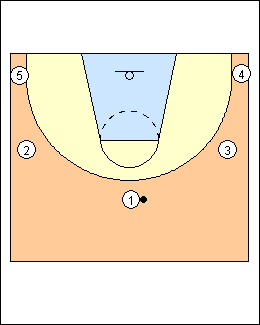 | 1 Lason Perkins Originators of open-post offence include Bob Huggins and John Brady. See Offence - Huggins open-post, Petitgoue open-post. Reasons to use it: - spacing - one defender can't guard two attackers (spacing is offence, and offence is spacing) - can be used with any kind of talent - good offence for a young team, teaching fundamentals of passing, screening, and (most importantly) moving - can use it as a delay game - a fun way to play the game. Basic elements - fill 5 spots on the floor - top of the key, wings, corners - always fill the spot closest to the ball - on a cut from the wing to the top of the key, cut to the "read spot" (middle of the foul line) and decide whether to pop out or backdoor cut to the basket - make a backdoor cut when the defence overplays - when a teammate dribbles towards your defender (basically screening him), loop around for a handoff (weave action), or backcut if he denies the handoff. Movement plus passing equals points, but there are times to use the dribble, - drive to the basket or drive and kick - get out of trouble, back it up - improve a passing angle (shorten a pass). Points of emphasis - always catch and face the basket - be ready on the weakside to fill cut, or get a drive and kick pass - reverse the ball, defences that stand still win (attack a bad close-out) - take the shot you want, not the shot the defence wants you to take - communicate with teammates, verbally and visually, especially in screening situations (call his name, raise a fist) - cut to the ball and shorten a passing lane - make sure that you can attack the boards and get second shots, and not give up easy shots at the other end. |
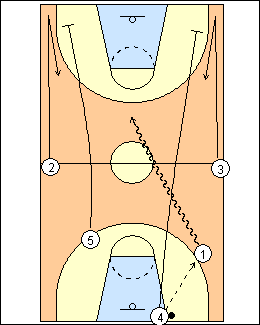 | 2 For a fast-break entry into open-post, have 4 inbound to 1 after a made basket, 2 and 3 run wide to the corners, 5 and 4 screen for them to pop out to the wings. The backcourt is the speed area, get the ball out of the net and upcourt as quickly as possible, but the frontcourt is a control zone, make good decisions. See Offence - Perkins open-post entries. |
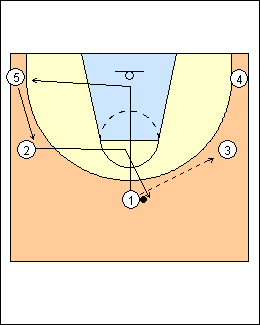 | 3 Cutting series Designed to be used against aggressive defences that pressure the ball and overplay passing lanes. Pass and cut every time, and always look to backdoor cut. 1 passes to 3 from the top of the key and cuts to the basket, 3 looks for the cutter. 2 fills the spot closest to the ball, he cuts to the read spot and pops out towards the ball, shortening the pass (not to the top of the key). 5 fills the wing, 1 fills the corner (he drop steps at the rim and backs out to keep vision on the ball). At the read spot, if your defender is below the foul line pop out toward the ball (shorten the pass), on a poor close-out, shoot or shot fake and drive. If the defender is on or above the foul line, cut backdoor to the basket. You can adopt a cutter rule for a poor ballhandler, he always cuts to the basket from the read spot. Cut all the way to the rim, good passers hit cutters late so they can go straight into their shot without dribbling. When replacing the cutter, wait until the ballhandler is done looking at the cutter. If the defence traps the wing, 2 just cuts directly to the top, and get somebody in the high post. About 30% to maybe 40% of their baskets come from backdoor cuts, and about 20-30% off drives (because of open gaps from all the cutting). They want 60% or more of shots to be inside the lane. One of the best ways to get rebounds is to follow a driver to the basket. They might come out a little higher late in a game when the other team is really trying to overplay and create turnovers. |
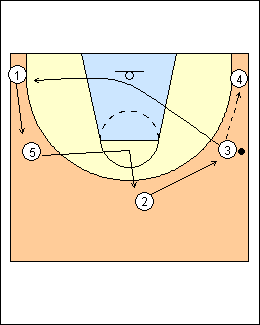 | 4 3 passes to 4 and basket cuts, 2 fills the wing (the closest spot to the ball), 5 cuts to the read spot and can backcut or pop out, 1 fills the wing. Perkins also teaches the corner player to dribble up to the wing, the cutter fills the corner. On a baseline drive, he wants fill-in behind and a baseline drift; on a middle drive, fill behind and fill the wing and corner areas. Post players or a guard with a mismatch in the post can post up for two seconds after a basket cut, then fill the open spot. Perkins has adopted the read-and-react concept of the whole 3-point line being a read spot, a fill cutter has to cut towards the basketball, not wide where the defence can run through the pass. |
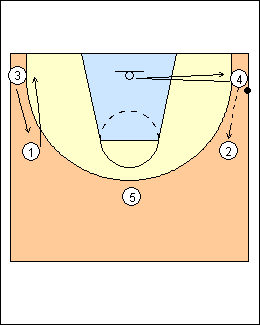 | 5 4 passes to 2, basket cuts, and pops back to the corner (the closest spot to the ball). 1 and 3 exchange on the weakside. Some teams screen up, 4 screens for 5 in the top spot, opening up the baseline for a drive by 2. Against zone defence, beat the zone up the floor before it sets up. Pass and cut into a gap (hook and look), hold that spot until the next pass is made, fill an open spot, and that could be a short corner (use the short corners, or mid-posts). To avoid confusion, use the same set against an even or odd front zone, anytime you get the ball in the corner it becomes a 2-3 zone, you flatten it out. |
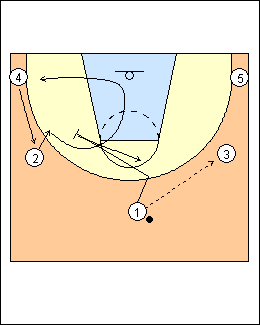 | 6 Screening series Screening is effective against teams that sag rather than overplay passing lanes. Pass and screen (away), the cutter curls off the screen to the basket, the screener steps back to the ball. Screens can be set from the top or the wing. You can still cut to the basket if overplayed, and use your dribble to attack. 1 passes to 3, cuts one step or two, screens for 2 with a verbal and visual signal, 2 sets up his defender, comes off the screen shoulder to shoulder and cuts to the basket, as soon as he clears, 1 steps back towards the ball looking for a pass. 4 fills the wing, 2 goes to the corner. Using only curl cuts initially eliminates reads, and a lot of teams don't really prepare to defend curls. You can teach reads once players become more familiar with the offence, e.g. the cutter can straight cut, fade cut, or turn down the screen and backcut. If X2 jumps with the ball into a help position in the middle of the floor, it takes away 1's screening angle, optionally the cutter v-cuts to set up his cut and fills the top, the corner player fills the wing, and the screener fills the corner. It becomes a basic downscreen situation where you catch the defender in the lane, set a good screen, and the cutter pops out. 2 can still curl if his defender trails. |
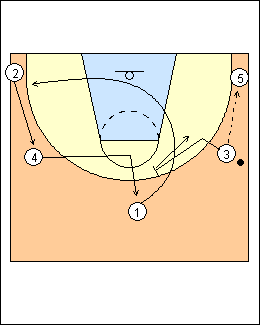 | 7 3 passes to 5 and screens away for 1, who curls the screen then 3 steps back to the ball. (When 5 passes out of the corner, he does not screen away) |
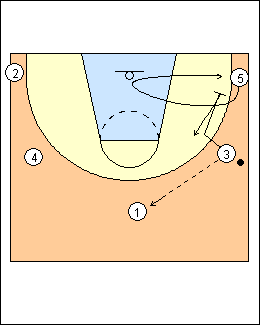 | 8 Here 3 passes to 1, screens away for 5, who curls the screen to the basket then pops back to the corner, 3 steps back to the ball. If the defence switches on screens, - go to the cutting series, - screen your own defender, - the screener slips, or - run "double cutter", the cutter curls and the screener follows right behind. Start with the cutting then screening series. First show 5 on 0, then do breakdowns (2 on 2, 3 on 3), breakdown drills, and 5 on 5 against overplay then sagging man defence. For breakdown drills, see Layups - Give and go and Shooting - Dribble hand-offs, Bauer two-ball screening. |
This page was made with Basketball playbook from Jes-Soft